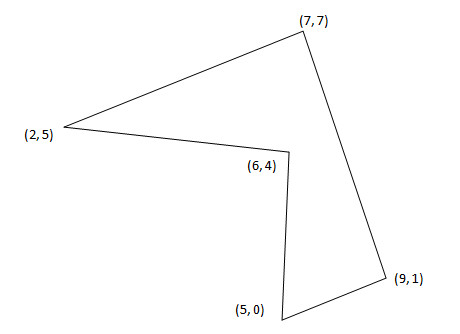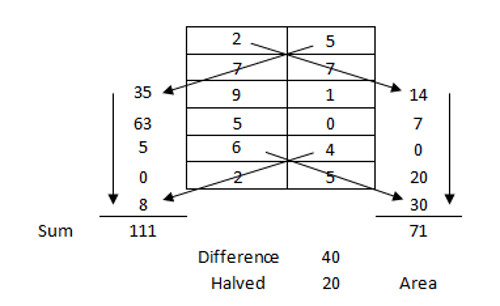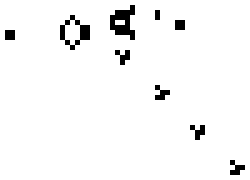Richard Feynman was so struck by this fact that he remembered ever afterward where he had learned it — from his childhood friend Morrie Jacobs as the two stood in Morrie’s father’s leather shop in Far Rockaway, Queens.
Science & Math
Area Matters

If you know the vertices of a polygon, here’s an interesting way to find its area:
- Arrange the vertices in a vertical list, repeating the first vertex at the end (see below).
- Multiply diagonally downward both ways as shown.
- Add the products on each side.
- Find the difference of these sums.
- Halve that difference to get the area.

This works for any polygon, no matter the number of points, so long as it doesn’t intersect itself. It’s a slight restatement of the shoelace formula.
(Thanks, Derek, Dan, and Kyle.)
Fortuitous Numbers
In American usage, 84,672 is said EIGHTY FOUR THOUSAND SIX HUNDRED SEVENTY TWO. Count the letters in each of those words, multiply the counts, and you get 6 × 4 × 8 × 3 × 7 × 7 × 3 = 84,672.
Brandeis University mathematician Michael Kleber calls such a number fortuitous. The next few are 1,852,200, 829,785,600, 20,910,597,120, and 92,215,733,299,200.
If you normally say “and” after “hundred” when speaking number names, then the first few fortuitous numbers are 333,396,000 (THREE HUNDRED AND THIRTY THREE MILLION, THREE HUNDRED AND NINETY SIX THOUSAND), 23,337,720,000, 19,516,557,312,000, 56,458,612,224,000, and 98,802,571,392,000.
And 54 works in both French and Russian.
(Michael Kleber, “Four, Twenty-Four, … ?,” Mathematical Intelligencer 24:2 [March 2002], 13-14.)
A Keypad Oddity
A.F. Bainbridge of British Aerospace noticed this curiosity in 1991. On a calculator keypad like this:
1 2 3 4 5 6 7 8 9
… choose two three-digit numbers (say, 435 and 667) and multiply them (290145). Now use symmetrical paths on the keyboard to find two “complementary” numbers (that is, symmetrical across the center, here 675 and 443) and multiply those (299025).
The difference between these two products (299025 – 290145 = 8880) will always be evenly divisible by 37.
(A.F. Bainbridge and P.A. Binding, “Symmetrical Paths on a Calculator,” Mathematical Gazette 75:474 [December 1991], 399-401.)
Finding the Way
https://www.youtube.com/watch?v=UDBAT-gW6hg
Kohta Suzuno of Japan’s Meiji University has devised a way to solve mazes using the Marangoni effect: Fill the maze with milk, place an acidic hydrogel block at the exit, and introduce dye and a soap at the entrance. The pH change alters the surface tension and drives the dye toward the block. “In a typical experiment, the shortest path can be found and visualized within ~10s.” Suzuno has even used this technique to find the shortest distance between two points in Budapest, using a maze modeled on a street map.
(Kohta Suzuno et al., “Marangoni Flow Driven Maze Solving,” in A. Adamatzky, ed., Advances in Unconventional Computing, Vol. 23, 2017.)
Math Notes
Andrew Bremner devised a magic square that expresses 652 as the sum of three squares in six different ways (the sum of each row and column):
152 202 602
362 482 252
522 392 02
(From Edward Barbeau, Power Play, 1997.)
The Allais Paradox
Consider two experiments — in each you’re asked to make a choice between two gambles:

In the first experiment, most people choose Gamble 1A over Gamble 1B. In the second, most people choose Gamble 2B over Gamble 2A. Neither of those choices, in itself, is unreasonable. But economist Maurice Allais pointed out in 1953 that choosing 1A and 2B together does appear inconsistent. To see why, refine the table a bit further:

Now it’s clear that, within each experiment, both gambles give the same outcome 89 percent of the time. The only thing to distinguish them, then, is the remaining 11 percent — and when we focus on those segments, Gamble 1A matches Gamble 2A, and 1B matches 2B. Any given individual might tend to prefer a sure thing or a gamble, but here, it seems, most people prefer the sure thing in Experiment 1 and the gamble in Experiment 2.
This doesn’t mean that most people are irrational, Allais argued, but rather that expected utility theory might not reliably predict their behavior.
Shortcuts
In a lecture at the University of Edinburgh in the 1970s, artificial intelligence pioneer I.J. Good pointed out that a robot cricket player doesn’t necessarily need a complex knowledge of physics in order to catch a ball — instead it might emulate humans, who follow a simple rule: “If the ball appears to be rising in the sky, run backwards. If it is falling, run towards it.”
Similarly, Hope College mathematician Tim Pennings noticed that his Welsh corgi, Elvis, seemed to follow the optimal path when chasing a ball thrown into Lake Michigan — Elvis seemed to realize that he ran faster than he swam, and so could minimize his retrieval time by racing intelligently along the beach before jumping into the water. But how did he make these judgments?
“We confess that although he made good choices, Elvis does not know calculus,” Pennings wrote. “In fact, he has trouble differentiating even simple polynomials.”
(Timothy J. Pennings, “Do Dogs Know Calculus?” College Mathematics Journal 34:3 [2003], 178-182.)
Friendly Fire
Here’s a little oddity that I just came across. John Conway’s Game of Life is a familiar recreation that takes place on a grid of squares. At the start each square is either “alive” or “dead,” and then on each turn the status of each square is updated:
- Any live cell with fewer than two live neighbors dies (as if by underpopulation)
- Any live cell with two or three live neighbors lives on
- Any live cell with more than three live neighbors dies (as if by overpopulation)
- Any dead cell with exactly three live neighbors becomes a live cell (as if by reproduction)
This produces some surprising creatures, such as the “glider,” a self-propagating “spaceship” that travels diagonally:

Gliders can be generated by an oscillating factory called a “gun”:

Here’s the oddity: It would seem that each gun will produce an infinite fleet, since its gliders all depart in the same direction. But that’s not true if the grid of squares is written on a torus — then the gliders snake around the figure and destroy their maker:
![]()
Light Exercise
What’s the smallest amount of information that will permit us to recognize an animated form as human? Study for Fifteen Points, by London-based art collective Random International, builds on the discoveries of Swedish perceptual psychologist Gunnar Johansson to show that a mere 15 moving points can suggest the gait of a walking person.
